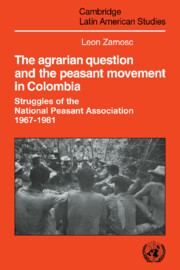 The Agrarian Question and the Peasant Movement in Colombia
The Agrarian Question and the Peasant Movement in Colombia Book contents
- Frontmatter
- Contents
- List of tables, figures, and maps
- Foreword by Tedor Shanin
- Foreword by UNRISD
- Acknowledgments
- List of abbreviations
- Map 1 Republic of Colombia
- Introduction
- 1 The agrarian question in Colombia
- 2 Reformism and the beginnings of the peasant movement
- 3 The radicalization of ANUC and the great waves of land invasions
- 4 Counterreform
- 5 The contradictory influences of peasant politicization
- 6 Concessions and repressive escalation
- 7 The new occupational alternatives and the issue of the rural proletariat
- 8 Partial repeasantization and the question of the new peasant settlements
- 9 Final crisis and clientelist regression of ANUC
- 10 Overview and final remarks
- Notes
- Bibliography
- Index
- Cambridge Latin American Studies
8 - Partial repeasantization and the question of the new peasant settlements
Published online by Cambridge University Press: 10 October 2009
- Frontmatter
- Contents
- List of tables, figures, and maps
- Foreword by Tedor Shanin
- Foreword by UNRISD
- Acknowledgments
- List of abbreviations
- Map 1 Republic of Colombia
- Introduction
- 1 The agrarian question in Colombia
- 2 Reformism and the beginnings of the peasant movement
- 3 The radicalization of ANUC and the great waves of land invasions
- 4 Counterreform
- 5 The contradictory influences of peasant politicization
- 6 Concessions and repressive escalation
- 7 The new occupational alternatives and the issue of the rural proletariat
- 8 Partial repeasantization and the question of the new peasant settlements
- 9 Final crisis and clientelist regression of ANUC
- 10 Overview and final remarks
- Notes
- Bibliography
- Index
- Cambridge Latin American Studies
Summary
As already indicated the gains made during the battles of the early 1970s had reduced the usuarios' combativeness in the main areas of land struggle. Two aspects were particularly relevant here: the partial satisfaction of land hunger and the disappointing results of the new peasant economy. Both will now be examined in greater depth as an introduction to the analysis of ANUC's performance in the new peasant settlements.
Marginal access to land as a palliative
Land hunger had been satisfied by greater access to land. The phrase “partial satisfaction,” which qualifies this achievement, must be explained and sustained by empirical data. The more general issue, of course, is the socioeconomic significance of the changes. This issue can be broken down into three central questions: What was the actual scope of the peasant gains? To what extent did these gains affect the existing patterns of land distribution? What was their place in the overall process of change in Colombia's countryside? In an attempt to answer these questions, the following discussion is based upon three main sources of information: the agricultural censuses of 1960 and 1970, the population censuses of 1964 and 1973, and the reports on INCORA's activities throughout the period 1962–1979.
INCORA's data on land redistribution and the allocation of titles to public land, presented in Table 8.1, provide a starting point to assess the gains of the land struggles. Redistribution was almost always a direct result of the struggle for land.
- Type
- Chapter
- Information
- The Agrarian Question and the Peasant Movement in ColombiaStruggles of the National Peasant Association, 1967–1981, pp. 146 - 178Publisher: Cambridge University PressPrint publication year: 1986


